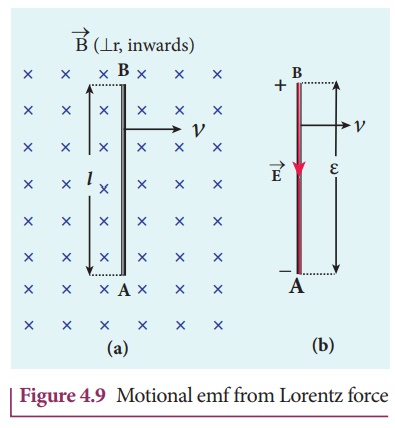Definition, Explanation, Formula | Electromagnetic Induction - Motional emf from Lorentz force | 12th Physics : Electromagnetic Induction and Alternating Current
Chapter: 12th Physics : Electromagnetic Induction and Alternating Current
Motional emf from Lorentz force
Motional emf from Lorentz force
Consider a straight
conducting rod AB of length l in a uniform magnetic field ![]() which is directed perpendicularly into the plane of the paper as shown in
Figure 4.9(a). The length of the rod is normal to the magnetic field. Let the
rod move with a constant velocity
which is directed perpendicularly into the plane of the paper as shown in
Figure 4.9(a). The length of the rod is normal to the magnetic field. Let the
rod move with a constant velocity ![]() towards right side.
towards right side.
When the rod moves, the
free electrons present in it also move with same velocity ![]() in
in ![]() . As a result, the Lorentz force acts on free electrons in the
direction from B to A and is given by the relation
. As a result, the Lorentz force acts on free electrons in the
direction from B to A and is given by the relation

The action of this
Lorentz force is to accumulate the free electrons at the end A. This
accumulation of free electrons produces a potential difference across
the rod which in turn establishes an electric field ![]() directed along BA
(Figure 4.9(b)). Due to the electric field
directed along BA
(Figure 4.9(b)). Due to the electric field ![]() , the coulomb
force starts acting on the free electrons along AB and is given by
, the coulomb
force starts acting on the free electrons along AB and is given by

The magnitude of the
electric field ![]() keeps on increasing as long as accumulation of
electrons at the end A continues. The force
keeps on increasing as long as accumulation of
electrons at the end A continues. The force ![]() E
also increases until equilibrium is reached. At equilibrium, the magnetic
Lorentz force
E
also increases until equilibrium is reached. At equilibrium, the magnetic
Lorentz force ![]() B and the coulomb force
B and the coulomb force ![]() E
balance each other and no further accumulation of free electrons at
the end A takes place.
E
balance each other and no further accumulation of free electrons at
the end A takes place.

The potential difference
between two ends of the rod is


Thus the Lorentz force on the free electrons is responsible to maintain this potential difference and hence produces an emf

As this emf is produced
due to the movement of the rod, it is often called as motional emf. If the ends
A and B are connected by an external circuit of total resistance R, then
current  flows in it. The
direction of the current is found from right-hand thumb rule.
flows in it. The
direction of the current is found from right-hand thumb rule.
Related Topics